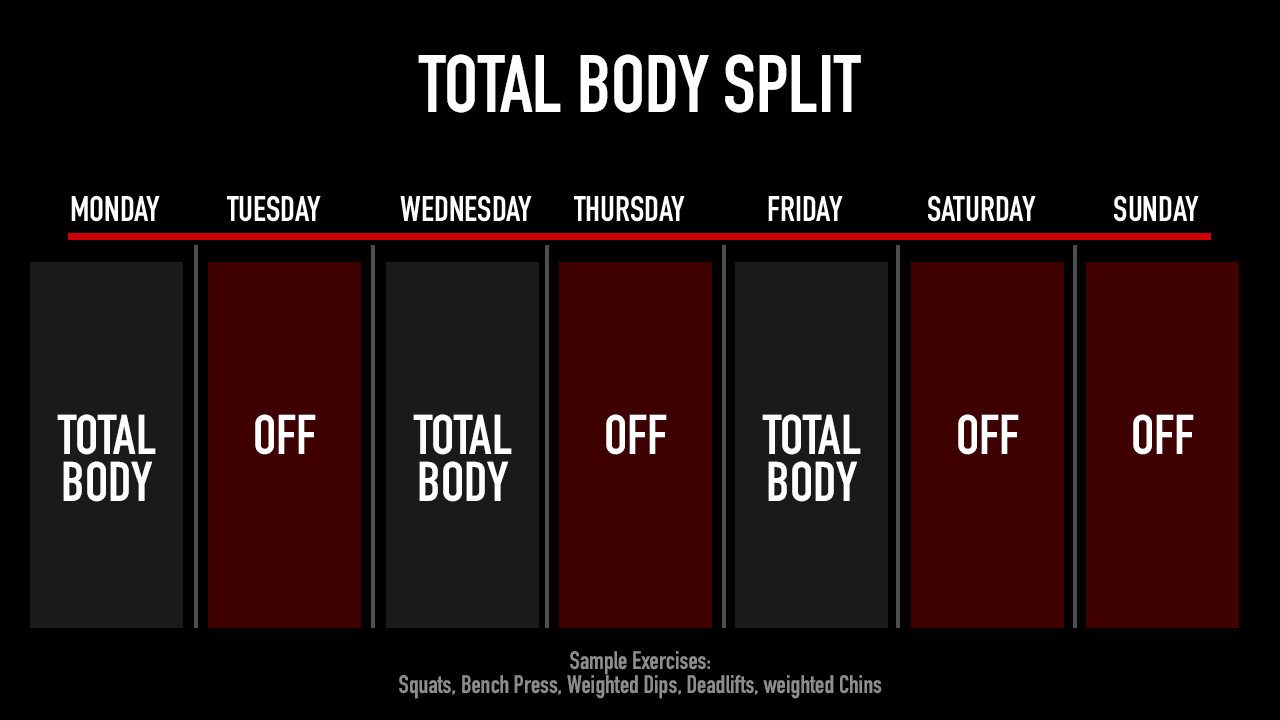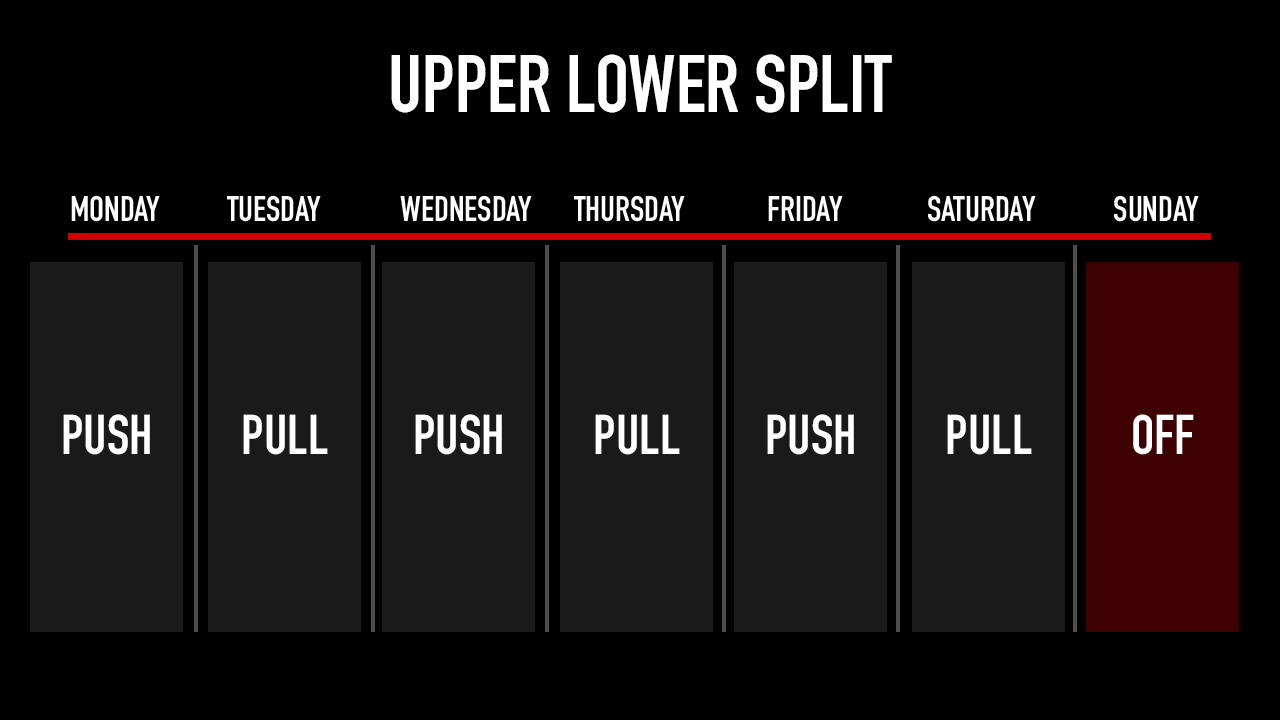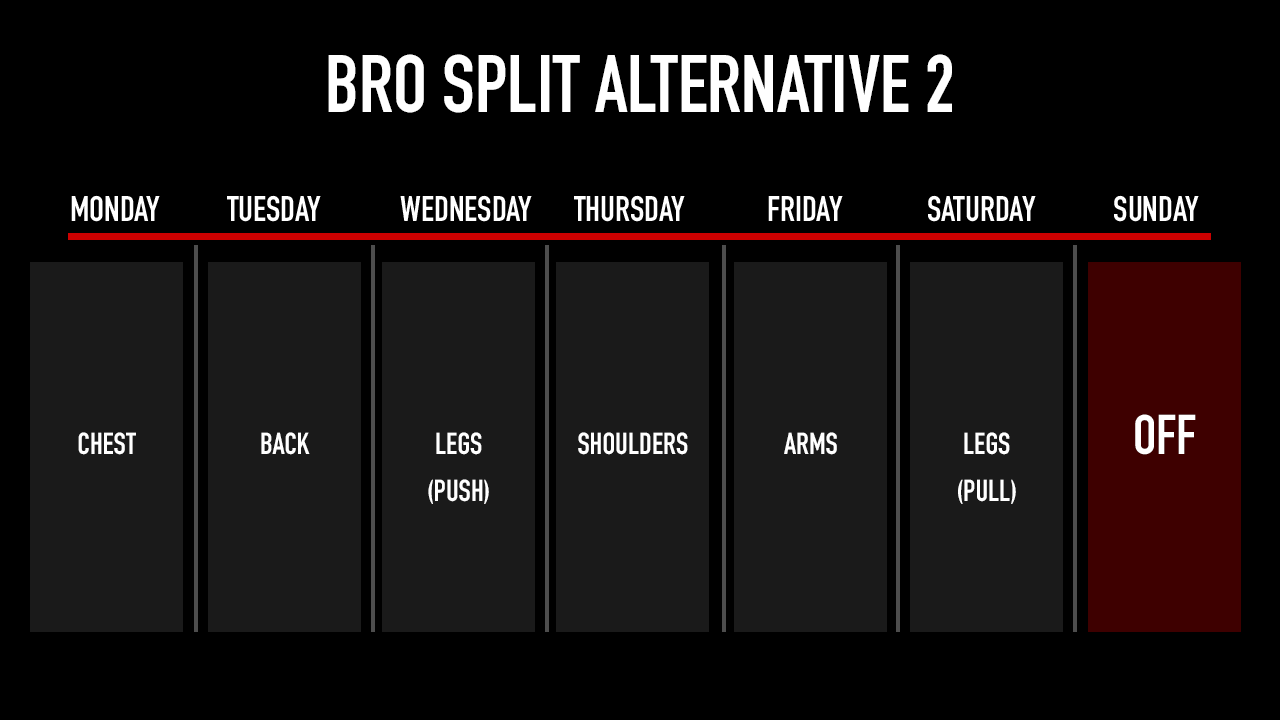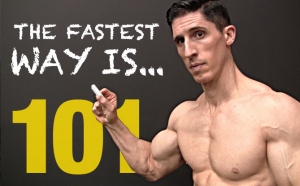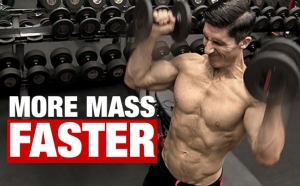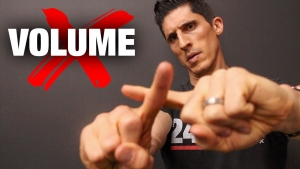
WHAT IS THE BEST WORKOUT SPLIT?
I get this question every day. “What is the best training split?” The answer is so complex that it would take 5000 YouTube videos to answer it.
Guys, there are plenty of options out there for the best training split. But the one that’s right for YOU probably isn’t right for your buddy.
To determine which training split is right for you, the biggest factors to consider are your fitness goals, training frequency, and experience, just to name a few things.
But I don’t want to send you down a rabbit hole, where you’ll inevitably find these so-called hard-and-fast rules that too many of you get caught up in.
I want you to walk away from this article knowing exactly which training split is best for you.
Let’s take a closer look at each of the best training splits that are out there.
We’ll also talk about how to match the right split to your personal goals, timeline, and experience.
TYPES OF TRAINING SPLITS
If you type “best workout splits” into Google, you’re going to get about a dozen options and thousands of opinions.
There might be more out there, but I’m going to focus on the four most popular training splits.
Why only four?
Because most of the other “splits” that are out there aren’t focused on how to separate muscle groups as much as how to adjust the acute variables.
For example, let’s say you want to do a 5 x 5 training “split” – this is when you perform five sets of five reps of an exercise.
Sure, you know your acute variables – sets, reps, weight, rest, etc. – but you still have to figure out how to separate the muscle groups.
And that means you need to break down the muscle groups according to the number of days per week you’ll train.
How many days per week will you train? Maybe a 5-day split? Or perhaps a 3-day split will work better.
See what I’m getting at here, guys?
There are really only four primary ways to separate the muscle groups according to the days of the week.
That’s why we’re only focusing on these four:
- Total Body Split
- Upper vs. Lower Split
- Push vs. Pull vs. Legs Split
- Bro Split
Let’s jump right into the four common training splits.
For each type of training split, I’m going to describe what it is, why I like it, and why it might not be the best option for you.
TOTAL BODY SPLIT
An entire body split refers to a workout routine where you train all major muscle groups of the body in a single session.
You’ll usually perform one exercise for each major muscle group. This is typically done with compound multi-joint exercises.
Attention is given to the secondary muscle groups like biceps and calves, but this happens after the larger muscles are taken care of.
HOW MANY DAYS DO YOU TRAIN?
For a beginner full-body split, you’re looking at the classic methodology of training everything on Monday, Wednesday, and Friday – or a similar number of days.
In other words, you’ll break this down into a 3-day workout split.
ADVANTAGES OF A TOTAL BODY SPLIT
Guys like Arnold Schwarzenegger were doing total body splits decades ago!
Here are a few reasons why I like total body splits:
Number one: You get a little more recovery in the week.
More days of rest is music to my ears because it gives your muscles the chance to regenerate and grow.
Number two: You’re getting more frequent stimulation of the muscles in your body – all of them.
You’re getting that opportunity to resume muscle protein synthesis every 48 hours or so, which is what the research is pointing us to.
Finally, number three: Total body workouts can help prevent imbalances since you’re training all muscle groups equally.
DISADVANTAGES OF A TOTAL BODY SPLIT
While I do recommend a total body split for most people, there are a few things that I’m not crazy about.
Full-body workouts can be longer than split routines since you’re addressing every major muscle group in one session.
This might not be ideal for those with time constraints.
There’s also potential for muscular imbalance if your total body program isn’t designed correctly.
If not designed correctly, you might end up giving more focus to certain muscle groups and neglecting others.
Finally, advanced lifters or bodybuilders might require more targeted weekly volume and intensity on specific muscle groups to induce hypertrophy.
In such cases, split routines can be more effective.
UPPER-LOWER SPLIT
An upper-lower split routine is a type of resistance training program where exercises are divided based on the primary muscle groups they target: upper body and lower body.
It’s sometimes called the Arnold Workout Split because he is one of several bodybuilders who popularized this type of split.
You might even hear this one called the Push Pull split, which is not to be confused with the Push Pull Leg split.
The general idea is to dedicate separate training days to each of these two regions.
HOW MANY DAYS DO YOU TRAIN?
Traditional upper-lower workout splits are quite intensive since they traditionally follow a 6-day split.
So, a push workout would be chest, triceps, shoulders, and quads.
For example, you would focus on the Bench Press, Triceps Pushdown, Lateral Raise, and Bulgarian Split Squat for 10-12 reps.
If you’re doing bodyweight movements, this could include Push-Ups, Diamond Push-Ups, Dive Bombers, and Air Squats.
Then a pull workout would be back, biceps, and hamstrings.
Another example of this workout would be T-Bar Row, Bicep Curls, Stiff-Leg Deadlifts, and Deadlifts. Rep ranges might change here based on your goal.
Again, if you’re choosing bodyweight exercises here, you could do Pull-Ups, Chin-Ups, and Single-Leg Deadlifts.
But you don’t necessarily need to follow this as a 6-day workout split, especially if you’re newer to working out.
You could start with a 4-day workout split, gradually progressing to a 4-6 day split as you get stronger and your recovery improves.
ADVANTAGES OF AN UPPER VS. LOWER SPLIT
An upper-lower split allows you to take one workout, break it down over two workouts and increase the volume of those exercises a little bit.
Yes, the frequency is greatly enhanced here with six workouts per week versus three, but the workouts are a little bit shorter.
The idea is the same because you’re still stimulating muscle protein synthesis every 48 hours.
This split also makes sure one half of your body gets a break while the other works, helping with recovery.
By splitting the body’s workout, you can also do more exercises for each muscle, which can be better for building muscle.
Plus, if you’re short on time one week, you can still give all your muscles some attention with just two workouts—one for the upper and one for the lower body.
The routine keeps things interesting, as you can mix up the exercises more.
By focusing on specific areas, you get a chance to really master the exercises, which is safer and more effective.
DISADVANTAGES OF AN UPPER VS. LOWER SPLIT
One significant issue is that it might not be ideal for those who can’t commit to training multiple days a week.
Since the split requires separate days for an upper and a lower body workout routine, it necessitates at least four days of training for comprehensive coverage.
Additionally, some people might feel they’re neglecting specific muscle groups if they don’t vary their routine enough.
Overemphasis on certain exercises could lead to muscular imbalances, where some muscles become stronger than their opposing counterparts.
There’s also the risk of overtraining; if someone tries to pack too many exercises into an upper or lower day, it could hinder recovery.
Lastly, newcomers to exercise might find it a bit complicated initially, as it requires a good understanding of which exercises target which muscle groups.
In essence, while the split can be effective for many, it might not be the best fit for everyone’s needs and lifestyles.
PUSH PULL LEGS SPLIT
The Push Pull Legs split (PPL) split is a popular workout structure that divides exercises based on their primary functions:
Push exercises essentially involve “pushing” the weight away from your body.
They primarily target the chest, shoulders, and triceps.
Common push exercises include Bench Presses, Overhead Presses, Push-Ups, Tricep Dips, and Tricep Extensions.
You’ll usually perform 2-3 movements per major muscle group.
Pull exercises involve pulling the weight towards your body.
Primary movements work the back and biceps.
Examples include Pull-Ups, Barbell Rows, Dumbbell Rows, Lat Pulldowns, and Bicep Curls.
As the name suggests, Leg Day exercises target the lower body, including the quadriceps, hamstrings, calves, and glutes.
Common leg exercises are Split Squats, Deadlifts, Stiff-Legged Deadlifts, Lunges, Leg Presses, and Calf Raises.
Many fitness enthusiasts and advanced bodybuilders favor the PPL split because it allows them to target specific muscle groups with greater intensity and volume per muscle group than a full-body workout.
It also provides adequate recovery time for each muscle group.
HOW MANY DAYS DO YOU TRAIN?
Typically, someone following a PPL routine would cycle through the three workouts consecutively, take a day off, and then repeat.
This makes it ideal for people – usually the advanced trainee – who prefer to hit a 6-day split. However, it’s also flexible enough to be adapted for fewer days.
Let’s say you’re still fresh to working out, especially with body part splits. If you wanted to go more toward a beginner level, you could opt for a lighter training frequency.
We could do a push workout on a Monday, then we could have a day off. We could do a single workout for legs on Wednesday, then a day off. A pull workout Friday, and a couple of days off.
In essence, we’re dramatically decreasing the overall training volume, but at least we’re still maintaining the benefits of those similar and shared functions.
ADVANTAGES OF AN PUSH PULL LEG SPLIT
With a Push Pull Leg split, the benefit is that you’re starting to train more athletically.
My big benefit with this split is that I get to pair muscles together that share similar functions.
So, I’m not thinking about a comprehensive strength training program for the chest only. I’m not thinking about triceps training.
I’m thinking about push training and applying the right training stimulus. We’re grouping muscles that tend to work together because athletically, that’s how we’re going to function.
This shift in perspective simplifies one’s training approach, allowing for a streamlined and purposeful gym session.
Since you’re grouping muscles that synergistically work together, it diminishes the risk of overtraining a particular muscle group.
The versatility of the PPL split is another attractive feature.
It’s moldable, fitting the needs of both novices and seasoned athletes. You can easily adjust the intensity, volume, and types of exercises based on your specific goals.
The design also provides flexibility in terms of frequency. Whether you’re someone who hits the gym almost daily or just a few times a week, the PPL split ensures all major muscle groups receive sufficient attention.
Personally, I’m a big fan of this training approach.
It not only resonates with natural body movements but also offers a strategic, athletic, and functional workout blueprint.
DISADVANTAGES OF AN PUSH PULL LEG SPLIT
One of the primary concerns is the commitment to frequency.
The PPL split often suggests working out six times a week, which might not be practical for those juggling busy schedules.
There’s also a risk of developing muscle imbalances if there’s too much focus on a favored group, like pushing exercises, at the expense of others.
Beginners might find the PPL’s intensity and volume daunting, potentially setting them up for discouragement.
Furthermore, with its frequent workout schedule, ensuring adequate muscle recovery becomes crucial, as failure to do so could lead to overtraining and injuries.
The split’s emphasis on the dominant movement as compound lifts might limit the opportunity for accessory exercises, which could be a concern for those wanting to target specific muscles.
Also, without sufficient exercise variety, there’s a risk of hitting plateaus in progress.
Lastly, the PPL split can be equipment-intensive, often necessitating access to a well-stocked gym.
If you have limited resources or a preference for home workouts, you might find the split challenging.
BRO SPLITS
A “Bro Split” is a classic type of training split that is used more now for memes and TikTok videos than it is taken seriously as a way to exercise.
There was a time when it was considered the classic bodybuilder split!
But here’s the thing… if designed correctly, the Bro Split can be a solid training split.
Bro Splits unfairly get a bad name… sometimes. Other times, it’s warranted.
The classic bodybuilding workout split is when you focus on one muscle group per day, but you perform more than one exercise per body part, somewhere in the range of 4-6 exercises.
There’s also a lot of time given to single-joint isolation exercises. Most look like this: shoulders, chest, triceps, back, biceps, legs, and then a day off.
Why is that not so good?
Because you’re sequentially overlapping shared functions. I’m going with a push muscle – shoulders – and then another push muscle with chest. And then another push muscle with triceps.
Where’s the recovery?
We know that when we do chest exercises, we’re going to impact the shoulders. If you do a Barbell Bench Press, you know you’re working the shoulders. Where’s the recovery from your shoulder training from the day before? You’re going from right a bench movement like the Incline DB Bench into a shoulder exercise.
Especially as a natural athlete, adequate rest and recovery is paramount.
But this is where the correct design can save the Bro Split. You can opt for something different.
HOW MANY DAYS DO YOU TRAIN?
There’s a different way to do Bro Splits that would actually make it a functional workout allowing for proper recovery and results.
This is another popular one: Chest, back, legs, shoulders, arms, and then legs.
In essence, you can treat it as a 4-day split, or 5-day workout split, depending on your goals and experience.
If this isn’t your first rodeo in the gym, you could do a 6-day workout split.
A 7-day training split might seem tempting with a Bro Split, but you need to remember that your recovery is just as important.
As you can see, it is possible to make a Bro Split actually work.
The way you make it work for you is based on exercise selection and then putting the workouts in the right sequence.
You avoid the negatives and benefit a bit more from the principles of what we established back with the total body workout split.
ADVANTAGES OF A BRO SPLIT
I’m going to talk about the pros of a Bro Split as it relates to the two versions I mentioned above.
One of its primary advantages is the intense focus it allows on individual muscle groups during each session.
By dedicating an entire workout to a single muscle, you can ensure a comprehensive and varied training experience, stimulating the muscle from different angles.
This approach not only offers the muscle an entire 48 hours of recovery, reducing the risk of overtraining but also allows for a diverse range of exercises, making workouts more engaging.
Many individuals appreciate the motivational boost they get from the pronounced “pump” of thoroughly working a muscle, enhancing their overall workout satisfaction.
Also, the Bro Split’s structure is clear-cut, which can be particularly appealing to beginners or those who value simplicity in their routines.
Despite requiring frequent gym visits, the Bro Split’s focus on individual muscles means that each session might be shorter, catering to those with time constraints.
A typical workout usually lasts around 45-50 minutes.
DISADVANTAGES OF A BRO SPLIT
One significant concern is the reduced training frequency of individual muscle groups, with most being addressed just once a week.
This infrequency might not capitalize on optimal muscle growth opportunities, especially given emerging research suggesting benefits from more regular stimulation.
Likewise, there’s a tendency within the Bro Split approach to focus heavily on “mirror muscles,” potentially sidelining less visible but equally crucial muscles.
This oversight can lead to muscular imbalances and even postural issues.
Timewise, dedicating an entire session to one muscle might not be the most efficient, particularly for those with limited weekly gym availability.
Additionally, the intense focus during that single session poses a risk of overworking a muscle.
From a functional fitness standpoint, the isolation-driven nature of the Bro Split may not always mimic real-world movement patterns, thereby limiting functional strength development.
The format might also feel monotonous to some, impacting long-term motivation.
Despite these cons, don’t just resort to Bro Split hate unless you’re talking about the classic (and comical) version of the split.
HOW TO PICK THE BEST TRAINING SPLIT FOR YOU
Now that you have some examples of how to think about splitting up your workouts, how do you decide which split is right for you?
Well, I’ve boiled this down to a few simple principles to consider and questions to ask yourself.
WILL YOU STICK TO IT?
For me, the first rule is, will you stick to it. The best training split is the one you’ll actually do with commitment.
For example, I don’t particularly like full body splits. I don’t necessarily like to have to train everything in a single session.
What if you don’t look forward to your workout because you’re dreading having to do everything in one session and feeling maybe too fatigued by the time your workout is over? Chances are, you’ll eventually give up on it or you won’t give your all.
I don’t care how effective the split is, a split not done is not effective.
So, you need to find one that fits your preferences – one you actually enjoy doing.
IS IT PREDICTABLE?
Another thing to consider is the predictability of the routine and whether or not that fits your schedule.
Take the Push Pull Legs split as an example. It can have either a day off in between the three days or at the end of the six days.
If you put that rest day in between the three days, it’s good because you’re giving yourself an extra rest day in between, but the rest days and training days shift every week. For some, this won’t be an issue, and they might actually prefer it.
For others, they like to keep the rest days and training days predictable.
Consider what you can do and what you prefer and see which training splits align with that.
WHAT IS YOUR GOAL?
The training split you pick should align with your fitness goals.
So, what are you trying to accomplish? Is muscle size your training goal? What about losing body fat? Or maybe you want to develop explosive power and athleticism?
Each of these goals can align with a different training split.
For example, if you’re a beginner, you might be best served with a total body split so that you’re able to build the all-too important neuromuscular connections.
After doing this for a few months, you might want to focus on muscle growth and strength gains. In this case, you might want to graduate to a Push Pull split.
What if you want to train more athletically? In that case, I’d recommend a Push Pull Leg split.
Think about what you want to accomplish and compare it to each of the effective training splits and what they can provide.
DON’T BE A SLAVE TO YOUR SPLIT
You know why splits are killing your gains, guys?
Because you’ve fallen in love with the same one too often and you stick with it for far too long.
We’ve all done this… we follow the same split much longer than we should. The other muscle groups that aren’t responding as well may not be getting enough stimulation.
So, you need to make sure you change your split up and then closely monitor what happens.
Do you continue building strength? Do you see development continue? Or do you see the opposite?
Do you start to become less strong in your training? Do you start seeing development taper off, or not look as good anymore?
If that’s the case, you should modify the split.
If you’re not making gains in strength, not making gains in hypertrophy, not changing in the mirror, or not satisfied with where you’re at, then it’s time to try a different split.
When you do start mixing up your routines and your splits, pay attention. Maybe you start to see changes and improvements in some areas, and maybe regressions in others.
This is how you become more educated as to how you need to put that workout together for yourself to allow for the best gains everywhere going forward.
The most important thing you can do in your training is make sure you are strategically varying your common workout splits.
Never listen to someone that tells you the ‘best training split’ to do unless they are aware of what your goals are and where in your training plan you currently are.
You should know what your goal is and have a purpose behind your training.
Remember, training without a purpose is just working out. If you want to get the fastest results, you need to have a clear game plan and some science behind what you do. Check out our ATHLEAN-X programs to see which ones best meet your fitness levels and goals!

- While there are many training split options available, the best one for you depends on various factors such as your fitness goals, training frequency, and experience, and what’s right for you may not be right for your buddy.
- There are four main types of training splits: the Total Body Split, the Upper vs. Lower Split, the Push vs. Pull vs. Legs Split, and the Bro Split.
- The Total Body Split involves training all major muscle groups in a single session. This method typically follows a 3-day workout routine. It offers the benefit of better recovery and ensures balanced training of all muscle groups. However, it can be time-consuming and might neglect specific muscles if not designed correctly.
- The Upper-Lower Split categorizes exercises based on whether they target the upper or lower body. This routine can be structured around a 4 to 6-day workout plan. It allows for concentrated training on specific body regions, but beginners might find it a bit intricate. Moreover, it necessitates a commitment to working out at least four days a week.
- The Push Pull Leg Split (PPL) organizes exercises by their fundamental actions: push, pull, and leg-centric movements. This method is often executed as a 6-day split. It groups muscles based on their shared functions, making workouts more functionally aligned. Despite its benefits, it may demand frequent training sessions and can be equipment-heavy.
- The Bro Split, when designed correctly, can be an effective workout regimen. It allows for an intense focus on individual muscles during each session, offering comprehensive training and a 48-hour recovery period. However, it may lead to issues such as reduced training frequency for individual muscles, risk of overworking, and potential neglect of less visible but crucial muscles, leading to imbalances.
- When choosing a training split, it’s essential to consider personal preferences, predictability to match one’s schedule, and alignment with specific fitness goals, ensuring long-term commitment and efficacy.
- Above all, be sure to change up your training split, watching your results (or regressions) closely and modifying accordingly.
BEST WORKOUT SPLITS FAQS
The most effective workout split depends on individual preferences and fitness goals.
The best training split is one that you can commit to consistently, aligns with your schedule, and meets your specific fitness goals, whether it's muscle growth, fat loss, or developing athleticism.
The four most popular training splits to choose from include the following:
- Total Body Split
- Push Pull Split
- Push Pull Leg Split
- Bro Split
If you’re willing and able to exercise during a 5-day split, you can consider the Push Pull split, the Push Pull Leg split, or the Bro Split.
All of these programs can be designed to fit a 5-day workout schedule, providing you with two days of rest and recovery time.
If you’re new to working out, it might be best to stick with a 3-day split such as a Total Body workout program.
The best 6-day split is going to be one of the following:
- Push Pull Split
- Push Pull Leg Split
- Bro Split
Each of these training splits can be designed in a way that allows for six days of training broken up or concluding with a day of rest.
What’s more, these workout sessions allow you to hit multiple muscle groups two times per week.
The traditional Bro Split is a training program where each workout session focuses on one specific muscle group.
It involves dedicating each day to one muscle group like shoulders, chest, or legs, followed by a rest day at the end of the week.
While once a popular bodybuilder routine, its efficiency is debated, but when designed correctly – pairing functional muscle groups together – it can be a legitimate workout approach.
The traditional Bro Split workout is not good because it doesn’t allow for proper recovery. This is because you’re performing the same function for days in a row.
However, if you switch up the Bro Split to separate and pair up functional muscle groups together, allowing for optimal recovery and 48-hour protein synthesis, then it can be a very useful training split.
For example, you can pair chest and biceps, legs, back and triceps, and shoulders and traps.
A good gym schedule is one that aligns with an individual's fitness goals, availability, and allows for adequate rest and recovery.
It should provide a balance of strength training exercises for each muscle group.
Consistency, variety, and regular progression are key components of an effective gym schedule.
The best workout split is determined by an individual's goals, experience, and how many days they can commit to the gym.
It ensures each muscle group gets adequate attention and recovery time.
Common splits include total body workouts, upper-lower splits, and push pull leg split routines.
The best 3-day workout split often – but not always – involves a total body approach, targeting all major muscle groups during each session.
Another option is the push pull leg split routine, where each day focuses on either push exercises, pull exercises, or leg workouts.
Both ensure a balanced training approach with ample recovery.
The best four-day split typically involves an upper-lower split routine, where two days target the upper body routine and two days focus on the lower body routine.
Another effective approach is to divide the days into specific muscle group combinations, like chest and back, arms and shoulders, and two leg days.
This provides a balance of volume per session and recovery between sessions for each muscle group.
REFERENCES

Jeff Cavaliere M.S.P.T, CSCS
Jeff Cavaliere is a Physical Therapist, Strength Coach and creator of the ATHLEAN-X Training Programs and ATHLEAN-Rx Supplements. He has a Masters in Physical Therapy (MSPT) and has worked as Head Physical Therapist for the New York Mets, as well as training many elite professional athletes in Major League Baseball, NFL, MMA and professional wrestling. His programs produce “next level” achievements in muscle size, strength and performance for professional athletes and anyone looking to build a muscular athletic physique.

















